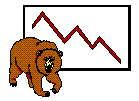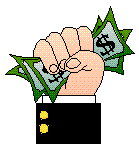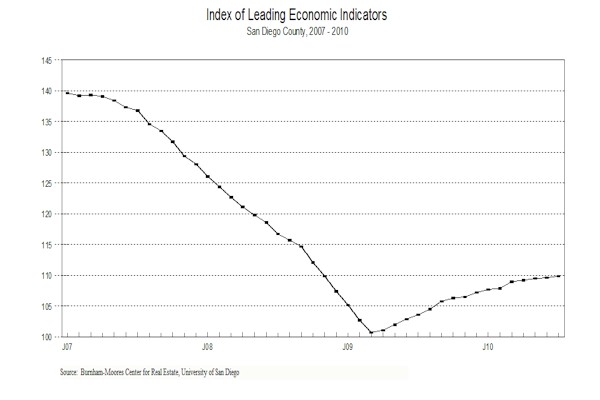|
Home
Leading Economic Indicators
Up in July
Note:
The tentative release date for next month's report is September 28.
August 31, 2010 -- The
University of San Diego's Index of Leading Economic Indicators for San Diego
County rose 0.3 percent in July. Leading the move to the upside were strong
gains in local consumer confidence and help wanted advertising. Building permits
and the outlook for the national economy were also positive, but to a lesser
extent. On the downside, initial claims for unemployment insurance rose sharply,
which is a negative, and local stock prices were down slightly. With July’s
gain, the USD Index has now increased for 16 months in a row.
 |
Index of Leading Economic
Indicators
The index for San Diego County that includes the
components listed below (July)
Source: University of San Diego |
+ 0.3 % |
 |
Building Permits
Residential units
authorized by building permits in San Diego County (July)
Source: Construction Industry Research
Board |
+ 0.29% |
 |
Unemployment Insurance
Initial claims for unemployment insurance in San Diego County, inverted
(July)
Source: Employment Development Department |
- 0.92% |
 |
Stock Prices
San Diego Stock Exchange Index (July)
Source:
San Diego Daily Transcript |
- 0.35% |
 |
Consumer Confidence
An index of consumer confidence in San
Diego County (July)
Source:
San Diego Union-Tribune |
+ 1.28% |
 |
Help Wanted Advertising
An index of online help wanted advertising in
San Diego (July)
Source: Monster Worldwide |
+ 1.08% |
 |
National Economy
Index of Leading Economic Indicators (July)
Source: The Conference Board |
+ 0.18% |
There have been concerns
about a possible "double dip" recession at the national level and similar
worries about the local economy. The USD Index remaining positive suggests that
a downturn in the local economy is not on the horizon, but as has been indicated
in previous reports, growth is likely to be very weak. What is keeping the
economy stagnant both locally and nationally is a high unemployment/low consumer
spending cycle. With the local unemployment rate above 10 percent for 14
straight months and incomes for many households flat or declining, consumer
confidence in the economy has fallen. With confidence down, consumers are
spending less and businesses are selling less, which means that hiring is slow
and the cycle is perpetuated. Through streamlining their operations to achieve
greater efficiency, companies have been able to earn solid profits even during
this downturn. Due to the streamlining, some of the jobs lost will never come
back, and the lack of consumer spending is causing some businesses to be content
with sitting on huge amounts of cash as opposed to hiring more workers. The
cycle seems to have stabilized in that the economy is not cycling downward, but
there is no upward momentum either.
Highlights: The trend
for residential units authorized by building permits was positive for the
eighth month in a row, although the gain was not very large. Developers are
reacting positively but cautiously to a housing market that has seen prices
increase by nearly 13 percent according to the Case-Shiller Home Price Index
since the bottom in April 2009. . . For the fourth straight month, initial
claims for unemployment insurance were negative while there was an increase
in help wanted advertising. The implication is that while businesses have
increased their hiring, job loss remains a big problem for the local economy.
The net result was that the local unemployment rate rose to 10.8 percent in July
from a rate of 10.5 percent in June. . . Local consumer confidence rose
for the third consecutive month as the raw value for that component reached its
highest level since September of last year. . . Local stock prices fell
with the rest of the financial markets as investors reacted to continued
negative economic data. . . While the national Index of Leading Economic
Indicators rebounded to a gain in July after falling the previous month, the
national economy continues to slow. The "second" estimate of Gross Domestic
Product (GDP) growth came in at a very weak 1.6 percent for the second quarter
of this year. This was after a gain of 5.0 percent in the fourth quarter of 2009
and 3.7 percent in the first quarter of 2010.
July’s increase puts the USD Index of Leading Economic Indicators for San
Diego County at 109.9, up from June’s revised reading of 109.6, down from the
originally reported level of 109.7. Revisions were made in the national Index of
Leading Economic Indicators for March, April, and June, but the only change was
in the level of the Index for June. Please visit the Website address given below
to see the revised changes for the individual components. The values for the USD
Index for the last year are given below:

For more information on the University of San Diego's Index of Leading
Economic Indicators, please contact:
|